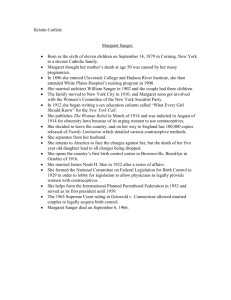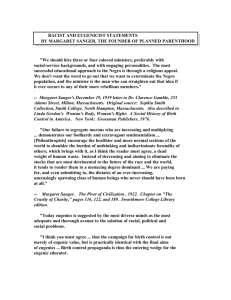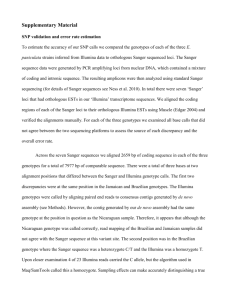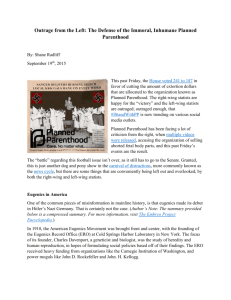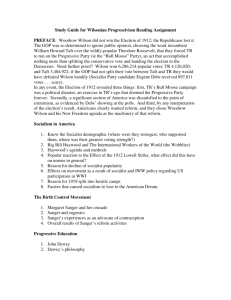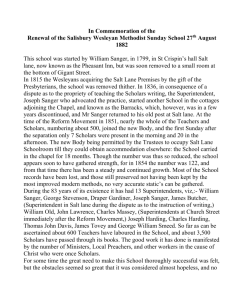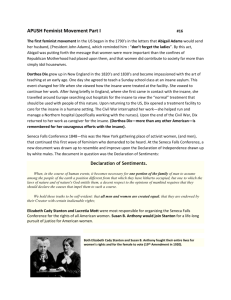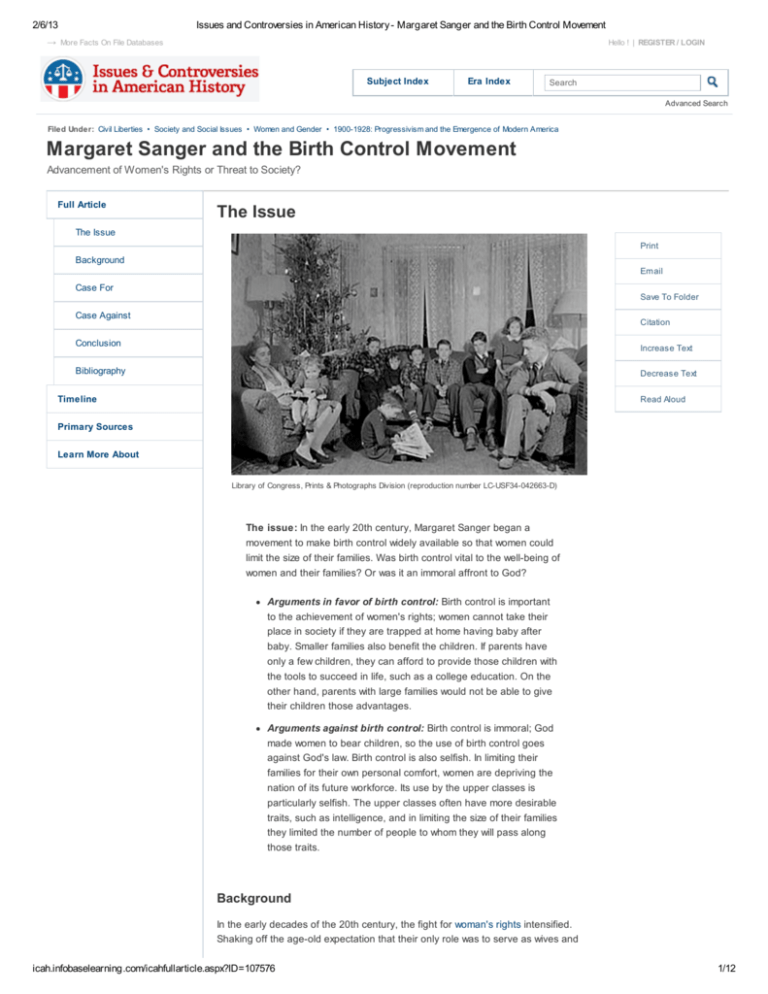
2/6/13
Issues and Controversies in American History - Margaret Sanger and the Birth Control Movement
→ More Facts On File Databases
Hello ! | REGISTER / LOGIN
Subject Index
Era Index
Search
Advanced Search
Filed Under: Civil Liberties • Society and Social Issues • Women and Gender • 1900-1928: Progressivism and the Emergence of Modern America
Margaret Sanger and the Birth Control Movement
Advancement of Women's Rights or Threat to Society?
Full Article
The Issue
The Issue
Print
Background
Email
Case For
Save To Folder
Case Against
Citation
Conclusion
Increase Text
Bibliography
Decrease Text
Timeline
Read Aloud
Primary Sources
Learn More About
Library of Congress, Prints & Photographs Division (reproduction number LC-USF34-042663-D)
The issue: In the early 20th century, Margaret Sanger began a
movement to make birth control widely available so that women could
limit the size of their families. Was birth control vital to the well-being of
women and their families? Or was it an immoral affront to God?
Arguments in favor of birth control: Birth control is important
to the achievement of women's rights; women cannot take their
place in society if they are trapped at home having baby after
baby. Smaller families also benefit the children. If parents have
only a few children, they can afford to provide those children with
the tools to succeed in life, such as a college education. On the
other hand, parents with large families would not be able to give
their children those advantages.
Arguments against birth control: Birth control is immoral; God
made women to bear children, so the use of birth control goes
against God's law. Birth control is also selfish. In limiting their
families for their own personal comfort, women are depriving the
nation of its future workforce. Its use by the upper classes is
particularly selfish. The upper classes often have more desirable
traits, such as intelligence, and in limiting the size of their families
they limited the number of people to whom they will pass along
those traits.
Background
In the early decades of the 20th century, the fight for woman's rights intensified.
Shaking off the age-old expectation that their only role was to serve as wives and
icah.infobaselearning.com/icahfullarticle.aspx?ID=107576
1/12
2/6/13
Issues and Controversies in American History - Margaret Sanger and the Birth Control Movement
mothers, women entered the workforce in greater numbers, became more involved
politically, won the right to vote, and fought for a constitutional amendment
guaranteeing equal rights between men and women. Paralleling those developments
was a movement to make birth control widely available to women; for, advocates
reasoned, women could not be liberated if they were trapped at home raising child
after child. Led by Margaret Sanger, the movement sought to overcome laws making it
illegal to provide women with birth control devices and even information about birth
control. [See Woman Suffrage, Feminist Movement]
Since the 1870s, federal law had made it illegal to send devices intended to prevent
conception or information about birth control through the U.S. mail. In addition, many
states had passed their own stricter birth control laws. However, a growing number of
women—largely in the middle and upper classes—sought to gain control over how
many children they had and when they conceived them. Some sought to limit
conception through natural means (such as abstaining from having sex) while others
tried to obtain birth control devices from Europe, at great cost.
As women fought for greater control over other spheres of their lives, they also fought
for the right to use contraception to gain control over their own bodies. In addition to
arguing from a women's rights perspective, advocates also presented birth control as
a social necessity. Poorer women could not afford to raise large families, they argued;
the strain of raising many children led to unhappy families and the inability to provide
for the children adequately, guaranteeing that they would never escape from poverty.
On the other hand, giving the poor access to birth control would guarantee that
women would only have as many children as they had resources to support, birth
control advocates contended.
The movement was led by Margaret Sanger, who was widely credited with coining the
term "birth control." Sanger—who had 10 brothers and sisters and claimed that her
mother had died early because "she had had too many children and had worked
herself to death"—was a trained nurse who worked in New York City's poorer
neighborhoods. Sanger credited her experiences working with the poor with
convincing her of the need to make information about birth control available. She
explained, "I found that the average person was as ignorant of sex matters as our
most primitive ancestors. There has been progress in every department of our lives
except in the most important—creation. So I came to the conclusion that the greatest
good I could do was to help poor women to have fewer children to be brought up in
want and poverty."
Sanger and others in the movement set
out to make information on birth control
widely available. The movement was
revolutionary at the time. In the early 20th
century, women were not expected to
enjoy sex; it was meant simply for
procreation, so if women were not going
to produce babies then there was no
reason to have sex. Furthermore, one did
not talk about matters related to sex at
the time. Yet Sanger and other members
of the movement began to discuss the
topic openly and advocated having sex
for pleasure rather than for procreation.
The movement encountered strong
opposition, particularly on religious
grounds. Birth control prevented the
Margaret Sanger, in a portrait from 1922.
Library of Congress, Prints & Photographs Division
carrying out of God's will, opponents
(reproduction number LC-USZ62-29808)
insisted, and women who used it were
immoral and selfish. As a result of the
opposition, Sanger and other movement leaders sometimes ran afoul of the law and
were arrested. However, that did not stop the movement, which paved the way for a
icah.infobaselearning.com/icahfullarticle.aspx?ID=107576
2/12
2/6/13
Issues and Controversies in American History - Margaret Sanger and the Birth Control Movement
long-lasting debate over birth control in the United States.
Birth control supporters insisted that it was a woman's right to choose to limit the
number of children to what she could comfortably raise. Birth control was vital to
women's rights, they said, because women could not take their full place in society if
they were trapped at home continuously having children. Smaller families also
benefitted the children, supporters said. If parents had only a few children, they could
afford to provide those children with the tools to succeed in life, such as a college
education, proponents asserted. On the other hand, they said, parents with more
children would be able to provide their children with none of those advantages,
ensuring that they would spend the rest of their lives in poverty.
Critics countered that birth control was immoral. God had made women to bear
children, so the use of birth control went against God's law, they insisted. The use of
birth control was also selfish, opponents asserted. For instance, they said, in limiting
their families for their own personal comfort, women were depriving the nation of its
future workforce. Use of birth control by the upper classes was particularly selfish,
critics charged. The upper classes often had more desirable traits, such as
intelligence, and in limiting the size of their families they limited the number of people
to whom they would pass along those traits, opponents said.
Early Family Planning in the U.S.
In the early history of the U.S., women did not have access to birth control other than
"natural" methods such as abstinence, male withdrawal during sex and scheduling sex
around the woman's menstrual cycle. Condoms made from sheep and other animal
intestines had been used for centuries, but they were expensive and had to be
imported from Europe and so were not widely available to the general American
population. (Condoms at the time were also mainly seen as a way to prevent the
spread of disease, not for contraception.) As a result, American women tended to
have large families. In 1800 there were am average of seven children per family.
In 1830, the first book on contraception to be published in the U.S. was released. In
the book, Moral Physiology: Or a Brief and Plain Treatise on the Population Question,
Robert Dale Owen (the son of women's rights leader Robert Owen) briefly discussed
the various means of preventing pregnancy. After debating the pros and cons of
those methods, he concluded that withdrawal was the most effective method.
According to Owen, limiting conception would have many benefits: "[It] would reduce
crime; it would decrease intemperance and profligacy; … it would relieve the burden
of the poor, and the cares of the rich; it would most essentially benefit the rising
generation by enabling parents generally more carefully to educate and more
comfortably to provide for their offspring."
Two years later, Massachusetts doctor Charles Knowlton built on Owen's work, going
into greater detail on the methods for preventing conception in Fruits of Philosophy;
Or, the Private Companion of Young Married People. However, where Owen
recommended withdrawal, Knowlton set out to find a new method, "some sure, cheap,
convenient, and harmless method, which should not in any way interfere with
enjoyment." His solution was for the woman to douche with a solution containing a
spermicide. By the end of the decade, more than 10,000 copies of Knowlton's book
had been sold. (Over the next 50 years, 277,000 copies were sold in the U.S. and
Europe.)
With more information about preventing conception available, the birthrate fell to 5.4
children per family by 1850. Several more books about limiting conception were
published in the 1850s, and advances in rubber manufacturing in the U.S. led to the
production of inexpensive latex condoms that the general public could afford to
purchase. The use of contraception became widely accepted, and advertisements for
contraceptives were common in newspapers and magazines.
Though many women benefited from the advancements in limiting conception, not
everyone was pleased with the developments. In 1873, anti-vice crusader Anthony
icah.infobaselearning.com/icahfullarticle.aspx?ID=107576
3/12
2/6/13
Issues and Controversies in American History - Margaret Sanger and the Birth Control Movement
Comstock successfully lobbied Congress to pass a law prohibiting the sale and
dissemination of certain "obscene" materials, including devices and information for
limiting conception, through the U.S. mail. Among other provisions, the law allowed the
prosecution of anyone who [See Comstock Act Targets Birth Control (sidebar);
Comstock Act (1873) (primary document)]
shall sell, or lend, or give away, or in any manner exhibit, or shall offer to
sell, or to lend, or to give away, or in any manner to exhibit, or shall
otherwise publish or offer to publish in any manner, or shall have in his
possession, for any such purpose or purposes, any obscene book,
pamphlet, paper, writing, advertisement, circular, print, picture, drawing or
other representation, figure, or image on or of paper or other material, or
any cast, instrument, or other article of an immoral nature, or any drug or
medicine, or any article whatever, for the prevention of conception, or for
causing unlawful abortion, or shall advertize the same for sale.
Comstock was appointed a special agent of the Postal Service to help enforce the socalled Comstock Act (also known as the Comstock Law). Under his watch, thousands
of people were arrested for violating the act.
Sanger Begins the Birth Control 'Revolution'
Despite the prohibition against limiting conception, a group of women and men
launched an effort to bring information about birth control to the public, working under
the banner of the "birth control" movement. Sanger, who herself had chosen to have
only three children, was the early leader of the movement. As a nurse working in some
of New York's poorest neighborhoods, she saw first-hand the effects of raising large
families on the health and quality of life of those families.
According to Sanger, her interest in the movement began in 1912, after a patient died
as a result of a self-induced abortion. After a previous abortion the woman, Sadie
Sachs, had asked a doctor for advice on preventing conception and had been told,
"Tell Mr. Sachs to sleep on the roof." In a later autobiography, Sanger wrote that after
Sachs's death, "I resolved that women should have knowledge of contraception. They
have every right to know about their own bodies. I would strike out. I would scream
from the housetops. I would tell the world what was going on in the lives of these poor
women. I would be heard. No matter what it should cost, I would be heard."
Sanger's first step was to publish a column in a socialist newspaper, The Call, entitled
"What Every Girl Should Know." Although the column discussed women's health,
hygiene and sexuality, it did not specifically mention contraception. Even so, the
column did not last long. In mid-1913, Comstock ordered the newspaper to stop
printing the column after Sanger wrote about venereal disease, and the newspaper
unhappily complied. In the following week's column under the heading "What Every
Girl Should Know," The Call wrote, "NOTHING; by order of the Post-Office
Department."
Sanger continued her efforts, however, with the publication of a newsletter called The
Woman Rebel, which contained information specifically about birth control. According
to Sanger, the goal of The Woman Rebel was "not to preserve a man-made world but
to create a human world by the infusion of the feminine element into all its activities."
Claiming that the newsletter violated the Comstock Law, the Postal Service refused to
distribute most of the issues of the newsletter. Stronger action was taken against
Sanger in August 1914, when she was arrested for violating the Comstock Law.
Rather than face charges she fled to England, which had long recognized the right to
disseminate information about birth control. There she studied England's successful
birth control movement and prepared to defend herself against the charges back
home. She also visited the Netherlands, where doctors had been operating birth
control clinics since 1878. At those clinics, she also learned how to fit women with
diaphragms, rubber devices that had been invented in Europe in the 1880s and were
used by women to block conception.
icah.infobaselearning.com/icahfullarticle.aspx?ID=107576
4/12
2/6/13
Issues and Controversies in American History - Margaret Sanger and the Birth Control Movement
Sanger decided to return to the U.S. in October the following year, ready to face the
obscenity charges against her and also to carry on the fight for birth control. With her,
she brought as many diaphragms as she could to distribute to women in the U.S.
Her obscenity trial began on January 8, 1916. However, a month later, the
government chose not to continue the prosecution. According to the court, "as it was
realized that the indictment was two years old, and that Mrs. Sanger was not a
disorderly person and did not make a practice of publishing such articles, the
Government had considered that there was reason for considerable doubt." However,
according to some newspapers, such as the New York Sun, the real reason was "the
Government's reluctance to be used as an instrument in giving publicity to sex
theories at this time."
After the government dropped the case, Sanger set out on speaking tour, visiting
more than 100 cities and towns to speak about birth control. Upon her return to New
York, she founded another publication, The Birth Control Review. However, she had
also become convinced that it was not enough simply to write about birth control. That
year, she founded the New York Birth Control League, and also opened the nation's
first birth control clinic to give poor women access to information about preventing
pregnancy.
Setbacks and Successes for the Movement
The birth control clinic opened the New
York City borough of Brooklyn on October
16, 1916. Less than two weeks later,
police raided the clinic and arrested
Sanger and the two other women who had
helped her establish the clinic: Fania
Mindell (an interpreter) and Sanger's
sister, Ethel Byrne (a nurse). After their
release, the three reopened the clinic,
only to see it shut down again. After they
reopened it a third time, the police
ordered the building's landlord to evict
them, permanently shutting down the
clinic.
Sanger and Byrne were charged with
violating a New York Law that made it
illegal to "sell, lend, or give away or to
Margaret Sanger, left, at a court
advertise, loan or distribute any recipe,
appearance in Brooklyn with her sister,
drug or medicine for the prevention of
Ethel Byrne, in January 1917. Sanger had
conception." Mindell was charged with
opened the first birth control clinic in the
United States.
violating obscenity law for selling copies
AP Photo
of The Birth Control Review. On January
8, 1917, Byrne was convicted of selling
birth control articles, and was sentenced to 30 days in a workhouse. Sanger was
convicted on February 3 and, like her sister, sentenced to 30 days in workhouse.
Mindell was also convicted, and was sentenced to a $50 fine.
Sanger appealed her case to the New York State Court of Appeals, hoping to win a
victory against the Comstock Act. The appeals court upheld Sanger's conviction on
January 18, 1918. However, in the case, judge Frederick Crane made an important
distinction that provided a boost to the birth control movement. He said that the court
upheld the charges only because Sanger was not a physician. He cited New York law,
which stated that "an article or instrument, used or applied by physicians lawfully
practicing, or by their direction or prescription for the cure or prevention of disease, is
not an article of indecent or immoral nature to use, within this article." He further noted
that the dictionary defined "disease" as "an alteration in the state of the body…
causing or threatening pain and sickness." That broad interpretation could apply to
pregnancy, and gave physicians license to discuss contraception with their married
icah.infobaselearning.com/icahfullarticle.aspx?ID=107576
5/12
2/6/13
Issues and Controversies in American History - Margaret Sanger and the Birth Control Movement
patients.
Meanwhile, Sanger and other leaders in the movement also began to advocate birth
control not just as a means to improve the lives of women and their families, but also
as a means to improve human heredity. During the early 20th century, a eugenics
movement had arisen in the U.S., holding that the human race could be improved
through selective breeding to pass on positive traits, such as intelligence, and to limit
negative traits, such as insanity and criminal tendencies. Some, such as Sanger,
argued that the "unfit" should be encouraged to use birth control to avoid passing on
those traits to later generations. Others pointed out that since it was difficult to obtain
information on birth control, only the upper classes could afford it; therefore, they
warned, the less fit lower classes were producing far more children than the upper
class, perpetuating what they termed "race suicide." [See Birth Control and the
Eugenics Movement (sidebar)]
The birth control movement gained momentum in the 1920s. In 1921, Sanger founded
the American Birth Control League "to build up public opinion so that women should
be able to demand instruction from doctors, to assemble the findings of scientists,
[and] to remove hampering Federal statutes" among other objectives. (The league
became the Planned Parenthood Federation in 1942.) She also organized the First
American Birth Control Conference in New York City in November.
However, the police—acting under the request of
New York City Archbishop Patrick Hayes—broke
up the birth control conference and arrested
Sanger and many others. The police action
prompted outrage from those who accused the
authorities of violating the right to free speech,
and resulted in an outpouring of support for
Sanger and the birth control movement. "If the
police deny even the right of assemblage to one
group of citizens, what is to stop them from
denying it to another group against which they or
their advisors have a personal prejudice?" asked
newspapers such as the New York Tribune.
In the wake of the favorable publicity, Sanger
decided to establish another birth control clinic,
this one staffed by physicians so it would be in
New York City Archbishop Patrick
Hayes, in an undated photograph.
Library of Congress, Prints &
Photographs Division (reproduction
number LC-DIG-ggbain-33825)
accord with New York State law. The clinic was called the Birth Control Clinical
Research Bureau and was staffed by 40 doctors. While Sanger maintained control of
the clinic, which opened in January 1923, a physician served as its director. The
nation's second birth control clinic opened in Chicago the following year.
Police raided the New York clinic in April 1929, again at the prompting of the
archbishop, and arrested the doctors and nurses working there. The raid evoked
greater sympathy for the movement, particularly among doctors. The New York
Medical Academy denounced the raid as a "grave menace to the freedom of the
medical profession within legal qualifications for the care and treatment of their
patients," and a number of doctors offered to testify in the clinic's defense during the
trial the following month. Judge Abraham Rosenbluth ruled in the physicians' favor,
finding, "If the doctor in good faith believes that the patient is a married woman, and
that her health requires prevention of conception, it is not crime to so advise and
instruct therein."
Although the birth control movement had made important progress in the century's
early decades, the debate continued. Was birth control vital to the well-being of
women and families? Or was it immoral and an affront to God?
The Case in Favor of Birth Control
Supporters of birth control insisted that it was vital if women were to achieve
icah.infobaselearning.com/icahfullarticle.aspx?ID=107576
6/12
2/6/13
Issues and Controversies in American History - Margaret Sanger and the Birth Control Movement
independence and take their rightful place in society. Women could not be free if they
were tied to the home raising a large number of children, proponents insisted. "[I]t is
essential to woman to know how to prevent conception. Without this knowledge, she
cannot win her moral, intellectual or economic freedom. It is primarily her fight, and
she must be back[ed] in it by every one who wishes to see her emerge from the sexbondage in which she has been held since the beginning of the Christian era," Walter
Adolphe Roberts wrote in the June 1917 issue of The Birth Control Review.
Marriage was a private matter, supporters declared; it was not for the state to
regulate. Therefore, they asserted, laws such as the Comstock Act were immoral, and
the government must remove birth control from their purview. They further pointed out
that women had played no role in the drafting of those laws. "The American people
have had nothing to do with the writing of these absurd laws upon their statute
books…. Women were not permitted to say a word, one way or the other, when laws
designed to prevent them from regulating their motherhood function were drawn up,
voted upon, signed and placed in operation by undemocratic men," Carrie Nelson
noted in The Birth Control Review in December 1917.
Birth control also contributed to women's health, supporters claimed. It prevented
them from dying in childbirth, they said, and also meant that they would not have to
result to dangerous illegal abortions to get rid of unwanted children. "In this country
our stupid and puritanical laws have been the cause of more than fifty thousand
annual deaths resulting from abortions. These laws have caused hundreds of
thousands of women to drag out a futile existence due to nervous exhaustion from too
frequent child-bearing," Sanger wrote in The Birth Control Review.
However, birth control was not just an issue of women's rights, supporters said. In
regulating births only to what a family could comfortably support, birth control
contributed to happier families, they said. And with fewer children to support, they
asserted, parents could provide their children with the opportunities they needed to
succeed in life, such as college educations. That was particularly true for poorer
families, who were producing far more children than they could support, dooming them
to lives of poverty, proponents maintained. Sanger elaborated in her 1920 debate with
Russell: [See Margaret Sanger Defends Birth Control in 1920 Debate (primary
document)]
On the one side we find those who do use means in controlling birth.
What have they?.... They are the people who have all the happiness, who
have the wealth and the leisure for culture and mental and spiritual
development. They are the people who rear their children to manhood
and womanhood and who fill the universities and colleges with their
progeny…. On the other hand we have the group who have large families
and have for generations perpetuated large families, and I know from my
work among these people that the great percentage of these people that
are brought into the world in poverty and misery have been unwanted….
In this group, what do we have? We have poverty, misery, disease,
overcrowding, congestion, child labor, infant mortality, maternal mortality,
all the evils which today are grouped in the crowd where there are large
families of unwanted and undesired children.
Supporters also contended that the laws against birth control had a larger impact on
the poor than on the upper classes, who had the resources to obtain information
about birth control and birth control devices. As a result, they said, the poor had much
larger families than those who were better off. And since more poor than rich people
tended to be "defective"—suffering from maladies such as insanity, criminal
tendencies and low intelligence—the imbalance in birth rates would contribute to a
less "fit" population over time. The only way to solve that problem, they insisted, was
making birth control widely available to the poor. Doctor Elizabeth Hamilton-Muncie
warned:
The results of [the law against birth control] are seen on every hand in
imbecility, insanity, truancy, criminality, arrested mental development,
icah.infobaselearning.com/icahfullarticle.aspx?ID=107576
7/12
2/6/13
Issues and Controversies in American History - Margaret Sanger and the Birth Control Movement
inefficiency, parasitism, and chronic invalidism. Persons in these classes
are increasing out of all proportion to the normal classes. In normal
families the average number of children is four; in degenerate families the
average is seven…. [T]he law says it is better to produce idiots than not
to produce at all, and where conditions are the vilest you find breeding
the most prolific.
Supporters refuted the argument that birth control should be prohibited because it
went against "natural law." They pointed out that man had exercised all sorts of
control over nature, such as by producing medicine to fight disease, and asked why
they should not apply the same effort to preventing births if it would improve lives. S.
Adolphus Knopf, a professor at the New York Post-Graduate Medical School and
Hospital, defended birth control in a 1916 speech to the Annual Meeting of the
American Public Health Association. He declared: [See S. Adolphus Knopf on 'Birth
Control in Its Medical, Social, Economic, and Moral Aspects' (Excerpts) (primary
document)]
If non-interference with thoughtless nature comprises one of the tenets of
the religion of others, to me man's intellectual control over nature's blind
forces and nature's thoughtless procreation of undesirable bacterial,
insect, or animal life, and his powers to bring forth more useful products
and make life for man, woman and child not only more bearable but even
more beautiful and glorious, are among the greatest proofs of the
existence of God's power in man. But the greatest of all achievements,
the most divine gift which God has bestowed upon man, is conscious
procreation. To me, judicious birth control under the guidance of the best
and ablest among our own profession, among the clergy and
sociologists, based on the highest conception of sanitary, medical, moral,
ethical and economic reasons, can well be considered a spiritual asset
which will uplift the race.
Finally, some birth control supporters also refuted the argument that in limiting
conception, women were killing souls waiting to be born. Those souls would simply be
born to other parents who wanted them, supporters said. "The mother…is the gate
through which an individual enters a new life on earth. When a mother refuses to help
build a body for an individual desiring to enter an earth life through her body she is
depriving that individual of her assistance in the matter. She is by no means killing
that individual, who may gain a body through the help of some other mother," Maude
Durand Edgren wrote in The Birth Control Review.
The Case Against Birth Control
The use of birth control went against nature, critics insisted. Sex was intended for
procreation, and in preventing conception, women denied God's will, they argued.
Archbishop Hayes argued strongly against birth control in his Christmas pastoral of
1921. "The Christ-Child did not stay His own entrance into this moral life because His
mother was poor, roofless and without provision for the morrow. He knew that the
Heavenly Father who cared for the lilies of the fields and the birds of the air loved the
children of men more than these," Hayes declared. He elaborated: [See New York City
Archbishop Hayes Denounces Birth Control (primary document)]
Heinous is the sin committed against the creative act of God, who
through the marriage contract, invites man and woman to co-operate with
him in the propagation of the human family. To take life after its inception
is a horrible crime; but to prevent human life that the Creator is about to
bring into the being is satanic. In the first instance, the body is killed,
while the soul lives on; in the latter, not only a body but an immortal soul
is denied existence in time and in eternity. It has been reserved to our
day to see advocated shamelessly the legalizing of such a diabolical
thing.
Millions of souls were waiting to be born, birth control opponents stated, and birth
icah.infobaselearning.com/icahfullarticle.aspx?ID=107576
8/12
2/6/13
Issues and Controversies in American History - Margaret Sanger and the Birth Control Movement
control deprived them of life. It was therefore murder, they insisted. Birth control "is
disastrous and perpetrates a great wrong upon the unborn millions who are waiting for
entrance upon this great amphitheater of life," attorney Winter Russell declared in
debating Sanger on birth control in 1920.
Birth control would also lead young people into sin since there were no repercussions
for having sex, critics warned. Without birth control, young people would have to wait
to have sex until after they were married because of the risk of pregnancy, they said.
Furthermore, critics declared, marriage without procreation, and sex purely for
pleasure, were morally wrong. During his debate with Sanger, Russell asserted:
I conceive and hold marriage to be more than physical. It is not a purely
sensual relationship. It borders on the aesthetic, spiritual mental, and
modern aspects of life, and when you try to take the physical by itself you
find a condition of naked sensuality which is disastrous in the extreme….
In the first place, fundamentally, universally, infinitely from every point of
view, it is vicious. It is false from every scientific construction that you can
possibly conceive of.
Other critics warned that the use of birth control by the upper and middle classes was
harming society by reducing the population of those of with more-desirable traits.
While the upper classes selfishly withheld the best from society, the poor, infirm,
criminal and insane continued to breed in large numbers, they warned, which would
result in a future population with more "unfit" than "fit" members. According to
Princeton University professor Edwin Conklin in Heredity and Environment (1915):
The cause for alarm is the declining birthrate in the best elements of a
population, while it continues to increase among the poorer elements.
The descendants of the Puritans and the Cavaliers, who have raised the
cry for "fewer and better children," are already disappearing, and in a few
centuries, at most, will have given place to more fertile races of
mankind…. No eugenical reform can fail to take account of the fact that
the decreasing birthrate among intelligent people is a constant menace
to the race. We need not "fewer and better children," but more children
of the better sort and fewer of the worse variety.
That disparity between birth rates for the upper and lower classes was also seen in a
disparity in the races, birth control critics warned. Those who practiced birth control
tended to be middle- and upper-class white Anglo-Saxons, while many of the poor with
large families were immigrants, they pointed out. Because of that difference, critics
warned that the use of birth control by the higher classes would lead to "race suicide."
Former President Theodore Roosevelt (R, 1901-09) elaborated in The Foes of Our
Own Household (1917): [See Former President Theodore Roosevelt Criticizes Birth
Control (Excerpt) (primary document)]
Among human beings, as among all other living creatures, if the best
specimens do not, and the poorer specimens do, propagate, the type will
go down. If Americans of the old stock lead lives of celibate selfishness…
or if the married are afflicted by the base fear of living which, whether for
the sake of themselves or of their children, forbids them to have more
than one or two children, disaster awaits the nation. It is not well for a
nation to import its art and its literature; but it is fatal for a nation to import
its babies.
Opponents further insisted that lowering the number of children per family would not
eliminate the problems facing society. Large families did not contribute to crime and a
decline in morality, they argued. They accused proponents of presenting birth control
as a cure-all for society's ills to gain support for their cause. In 1916, a meeting of
Medical Society of the County of New York voted against amending state laws to allow
birth control, declaring, "We claim no satisfactory evidence has been adduced by the
propagandists, who favor regulating the control of births to show any necessity for
giving recognition by law…. [W]e do not believe that small families, especially among
icah.infobaselearning.com/icahfullarticle.aspx?ID=107576
9/12
2/6/13
Issues and Controversies in American History - Margaret Sanger and the Birth Control Movement
the poor classes, will bring about, as claimed, a solution of the economic and social
problems of the day."
In fact, some critics cautioned that reducing the population was harmful, not a goal to
try to reach. The large population of working-class people served as the backbone of
the nation's economy, they said, taking on jobs that the upper classes refused to do.
That population of workers would be reduced through birth control, they warned. "It
should be considered that quantity is needed as well as quality," Dr. George Kosmak
declared during a 1917 meeting of the Society of Medical Jurisprudence.
Overall, birth control opponents insisted, it was morally wrong and selfish not to have
large families. Roosevelt criticized those who chose to limit the number of children
they bore. "[T]he root trouble is probably moral; and in all probability the whole trouble
is moral , and is due to a complex tissue of causation in which coldness, love of ease,
striving after social position, fear of pain, dislike of hard work and sheer inability to get
life values in their proper perspective all play a part," he declared.
Birth Control Enters the Mainstream
In the early 20th century, Margaret Sanger launched a movement to provide women
with information about birth control. The movement achieved a major success in the
1920s with the establishment of physician-staffed birth control clinics, but Sanger did
not end her efforts there. In 1929, she began a fight against the Comstock Law itself,
which made it illegal to disseminate birth control devices and information through the
mail. To raise money and lobby legislators, Sanger established the National
Committee on Federal Legislation for Birth Control.
She was unsuccessful in getting Congress to amend the Comstock Act to remove the
birth control provisions, but the movement won a victory later that decade when the
Circuit Court of Appeals affirmed physicians' rights to inform women about birth
control. Sanger had set out to test the Comstock law by ordering diaphragms from
Switzerland, to be delivered to the director of the Clinical Research bureau, Dr.
Hannah Stone. U.S. Customs confiscated and destroyed the diaphragms, and
confiscated a second shipment as well. Sanger then took the case to court, claiming
that Customs was interfering with doctors' right to serve their patients.
The so-called One Package Case went to trial in December 1935. In his decision in
the case, judge Grover Moscowitz of the U.S. District Court for the Eastern District of
New York ordered Customs to hand over the confiscated diaphragms to Stone.
Moscowitz declared that the court "could not assume that Congress intended to
interfere with doctors prescribing for the health of the people." The U.S. Circuit Court
of Appeals for the Second Circuit upheld his ruling the following year. Sanger
declared the decision "the greatest victory in birth control history," and Stone later
declared that with the decision, the judiciary "once and for all established
contraception as a recognized part of medical practice and removed the last legal
barriers to the dissemination of contraceptive knowledge."
With the court's decision, U.S. companies were now allowed to import birth control
devices from Europe. Meanwhile, more American companies were beginning to
manufacture them as well. In fact, according to author Deborah Bachrach, writing in
The Importance of Margaret Sanger (1993), the manufacture of birth control devices
was the one area in U.S. industry that grew dramatically during the Great Depression
of the 1930s. As a result of the birth control movement's successes and advances in
the production of birth control devices, the U.S. birthrate fell to just over two children
per woman by 1940.
The movement took another leap forward with the creation of the birth control pill,
which gave women a simple, safe and effective way to prevent pregnancy and
ushered in a "sexual revolution." The creation of "the pill," as it was widely known, was
spurred by Sanger, who raised funding for the project and recruited biologist Gregory
Pincus and physician John Rock to develop the pill. The Food and Drug
Administration (FDA) gave the pill its approval in 1960.
icah.infobaselearning.com/icahfullarticle.aspx?ID=107576
10/12
2/6/13
Issues and Controversies in American History - Margaret Sanger and the Birth Control Movement
The movement won another success in 1965, when the Supreme Court recognized
the right of married couples to use birth control in the case Griswold v. Connecticut.
With its 7-2 decision in the case, the court struck down an 1879 Connecticut law that
prohibited the use of birth control, declaring that it violated the privacy of married
couples. In its majority opinion, the court declared that the case concerned "a
relationship lying within the zone of privacy created by several constitutional
guarantees." In his concurring opinion, Justice Arthur Goldberg insisted that "the right
of privacy in the marital relation is fundamental and basic." (The Supreme Court
extended that right to unmarried couples in 1972 in Eisenstadt v. Baird.) [See
Supreme Court Opinion and Dissent: Griswold v. Connecticut (Excerpts) (primary
document)]
Sanger lived long enough to see those major successes for the movement that she
had launched. She died of congestive heart failure on September 6, 1966. The day
after she died, the New York Times described her as "one of history's great rebels
and a monumental figure of the first half of the twentieth century." However, she died
before could see the realization of one of her major goals: the end of the Comstock
provisions against birth control. Congress amended the act in 1971 to remove birth
control from its authority.
Nearly a century after Sanger began the birth control movement, birth control was
officially decriminalized and its use was widely accepted. It bore out the words of judge
William Wadhams, who in 1916 refused to convict a poor woman for using birth control
because her husband had lost his job and could not support a large family. "I believe
that we are living in an age of ignorance which at some future time will be looked upon
aghast as we look back upon conditions which we now permit to exist," the judge had
stated.
Bibliography
"Archbishop Hayes on Birth Control." New York Times, December 18, 1921,
http://www.nytimes.com.
Bachrach, Deborah. The Importance of Margaret Sanger. San Diego: Lucent Books,
1993.
Back, Kurt. Family Planning and Population Control: The Challenges of a Successful
Movement. Boston, Mass.: Twayne Publishers, 1989.
Chesler, Ellen. Margaret Sanger and the Birth Control Movement in America. New
York: Simon & Schuster, 1992.
Conklin, Edwin. Heredity and Environment in the Development of Men. Princeton, N.J.:
Princeton University Press, 1915.
Grossberg, Michael. Governing the Hearth: Law and the Family in Nineteenth-Century
America. Chapel Hill: University of North Carolina Press, 1985.
Jensen, Robin. Dirty Words: The Rhetoric of Public Sex Education, 1870-1924.
Champaign: University of Illinois Press, 2010.
Kennedy, David. Birth Control in America: The Career of Margaret Sanger. New
Haven, Conn.: Yale University Press, 1970.
Lader, Lawrence. The Margaret Sanger Story. New York: Doubleday, 1955.
Marchang, James. The Control of Parenthood. New York: G.P. Putnam's Sons, 1920.
Reed, James. From Private Vice to Public Virtue: The Birth Control Movement and
American Society Since 1830. New York: Basic Books, 1978.
Reed, Miriam. Margaret Sanger: Her Life in Her Words. Fort Lee, N.J.: Barricade
icah.infobaselearning.com/icahfullarticle.aspx?ID=107576
11/12
2/6/13
Issues and Controversies in American History - Margaret Sanger and the Birth Control Movement
Books Inc, 2003.
Roosevelt, Theodore. The Foes of Our Own Household. New York: George Doran
Company, 1917.
Sanger, Margaret, Frederick Blossom, Elizabeth Stuyvesant, and Walter Roberts, eds.
The Birth Control Review, Volumes 1-3. New York: Da Capo Press, 1917.
Straus, Sylvia. Traitors to the Masculine Cause: The Men's Campaigns for Women's
Rights. Westport, Conn.: Greenwood Press, 1982.
Sutherland, Halliday. Birth Control: A Statement of Christian Doctrine against the NeoMalthusians. New York: P.J. Kennedy & Sons, 1922.
Tone, Andrea. Devices and Desires: A History of Contraceptives in America. New
York: Macmillan, 2002.
Ware Dennett, Mary. Birth Control Laws: Shall We Keep Them, Change Them, or
Abolish Them. New York: F.H. Hitchcock, 1926.
Citation Information
MLA
Chicago Manual of Style
Kauffman, Jill. “Margaret Sanger and the Birth Control Movement.” Issues & Controversies in American
History. Infobase Publishing, 15 Jan. 2011. Web. 6 Feb. 2013.
<http://icah.infobaselearning.com/icahfullarticle.aspx?ID=107576>.
How to Cite
RECORD URL: http://icah.infobaselearning.com/icahfullarticle.aspx?ID=107576
↑ Return to Top
Articles you might also like...
1-3 of 3
Equal Pay Act of 1963
Should Employers Be Required to
Pay Women and Men Equal
Wages?
Roe v. Wade Decision
Is Abortion Murder or Do Women
Have a Fundamental Right to the
Procedure?
June 10, 1963
January 22, 1973
Woman Suffrage
A Right or a Privilege?
August 26, 1920
Sources
American Presidential Elections
Help
Terms of Use
Editorial Cartoons and Questions
How to Cite
Privacy Policy
Enhanced Lessons
------------
About Facts on File
Search by Standards
→ More Facts On File Databases
Contact Us
Teacher Resources
Copyright © 2013 Facts On File. All Rights Reserved.
Select Language
Pow ered by
Translate
icah.infobaselearning.com/icahfullarticle.aspx?ID=107576
12/12

